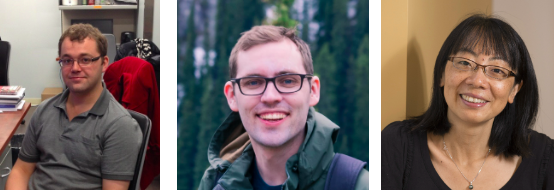- Congratulations to Huayin Luo
We would like to congratulate Huayin Luo on receiving the UROP and the SUD award.
- Welcome Lucinda Zhu to Zhen Lab
Zhen Lab extends a warm welcome to Lucinda Zhu, our newest addition to the team!
- Welcome to our undergraduate ROP students for Fall/Winter 2023-24!
Welcome to Zhen Lab – Xindi Tao, Michael Cheng, and Yuna Lee! We’re thrilled to have you join us for the Fall/Winter term as undergraduate ROP students.
- Welcome Sruthy and Tian!
Zhen Lab extends a warm welcome to Sruthy Ravivarma and Tian Du, our newest additions to the team!
- SUDS Scholars Showcase their Newly Acquired Data Science Skills
The SUDS showcase offered a platform for the scholars to share their final findings and also allowed students to recognize their peers’ exceptional posters and presentations. Congratulations to Shuyu Van Kerkwijk for receiving an award on her exceptional poster!

- LTRI OSOTF Award 2023-24 Congratulations ! A. LOVE
We would like to congratulate Alanna Love on receiving the OSOTF award at the Lunenfeld Tanenbaum Research Institute for the second time!
- 2023 Summer Student Poster Session
Our brilliant summer students – Danish Islam, Congrong (Ruby) He, Shuyu van Kerkwijk, and Huayin Luo – showcased their cutting-edge research at the 2023 Summer Student Poster Session held at the LTRI.
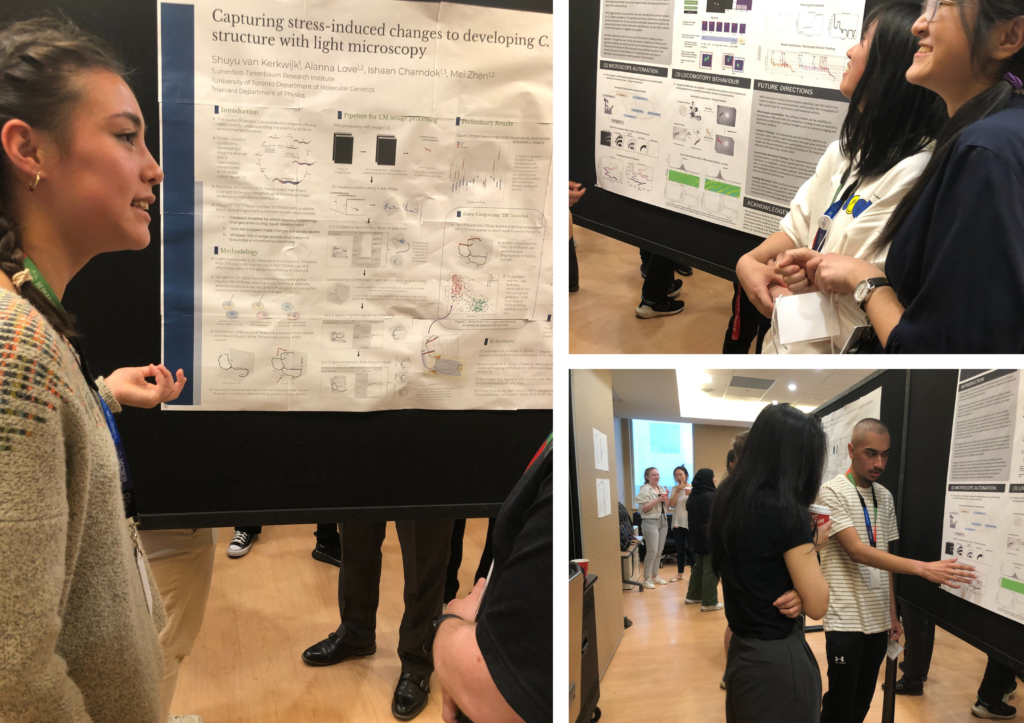
- Welcome Back, Maggie!
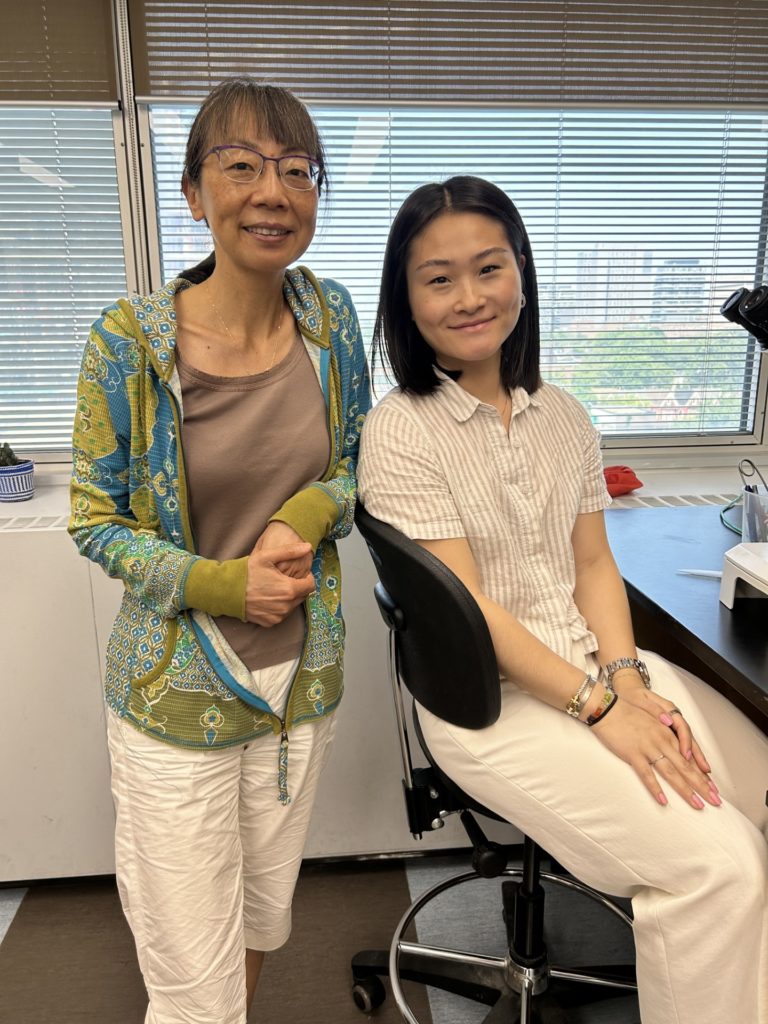
We extend a warm welcome back to Alumni, Maggie Chang as a visitor in Zhen Lab!
- Mohammad and Harvard
Congratulations to Mohammad Haddadnia! It is wonderful to have worked with you throughout the 4 years! Enjoy your graduate study at Harvard University!
- Ishaan and Harvard
Congratulations to Ishaan Chandok for his admission into Harvard University! Good luck with your PhD. We will miss you.
- DSI SUDS Scholar 2023
We are delighted to congratulate Congrong (Ruby) He for being chosen as a recipient of the 2023 SUDS Research Opportunity. Congrong (Ruby) will be working in Zhen Lab as a SUDS Scholar on Applying Data Science Tools to Examine the Computational and Operational Principles of an Intact Neural System.
- Summer Students 2023
Welcome to our undergraduate students joining Zhen Lab this summer – Congrong (Ruby) He, Danish Islam, Huayin Luo and Shuyu van Kerkwijk. We are thrilled to have all of you working with us!
- Sodium leak currents may reveal pathways of disease in the brain
Congratulations to Stephan Pless and Mei Zhen for receiving funding from the Lundbeck Foundation.
Stephan Pless’ project dives into the role of an evolutionarily conserved sodium leak current in brain development and disease.
Normal brain function is based on neuronal activity, most of which originates from tiny electrical currents generated by ions moving across cell membranes. The threshold for when these minute currents result in for example action potentials, and thus cellular signaling, critically depends on the so-called resting membrane potential. This resting membrane potential is regulated by a massive protein complex, the sodium leak channelosome, which is composed of the pore-forming NALCN channel and its auxiliary subunits FAM155A, UNC79 and UNC80. Mutations in this protein complex increase or decrease channelosome activity, leading to devastating and often fatal developmental and neurological defects in humans.
The project “The role of an evolutionarily conserved sodium leak current in brain development and disease” will test and investigate how these mutations effect the structure and function of the developing nervous system.
The collaboration between the teams of Professor Stephan Pless, University of Copenhagen, and Professor Mei Zhen, University of Toronto, also aims to develop the first set of NALCN-targeting lead compounds, both small molecules and peptides. This has the potential to ultimately treat humans suffering from dysregulations in the resting membrane potential, a condition that is thus far untreatable.
- Two Muscle-Specific and Direct Transcriptional Targets of DAF-16/FOXO Activated by Reduced Insulin/IGF-1 Signaling
A new preprint at BioRxiv: Two Muscle-Specific and Direct Transcriptional Targets of DAF-16/FOXO Activated by Reduced Insulin/IGF-1 Signaling (PDF)
C. elegans insulin/insulin-like growth factor 1 signaling (IIS) affects diverse physiological processes through the DAF-16/FOXO transcription factor. Despite its presence in all somatic cells, DAF-16’s physiological effects, such as modulation of dauer formation, synapse maturation, axon regeneration, and adult longevity, exhibit prevalent tissue-specificity as well as tissue crosstalk. This implies that tissue-specific DAF-16 transcriptional programs contribute to the functional diversity of IIS. To further examine this possibility, we sought to identify tissue-specific and direct transcriptional targets of DAF-16 in muscle cells. Following FACS-sorting to enrich mature muscle cells from young adult animals, we compared the muscle transcriptomes under high and low IIS states, with and without DAF-16. We further analyzed and compared the DAF-16 docking sites in muscle and intestine cells from published datasets. These analyses revealed 14 potential muscle-specific DAF-16 transcriptional targets, among which we validated two that are strongly and specifically activated by DAF-16 in muscles: a secreted protein C54F6.5 and a calcium-binding protein CEX-1/Calexcitin. Both genes exhibit DAF-16-independent non-muscle expression, explaining their low rank or absence from the current DAF-16 target lists generated by multiple independent whole-animal microarray or mRNA-sequencing analyses. These results support the notion of tissue-specific DAF-16 transcriptional programs and highlight the importance of verifying FOXO targets in a cell-type-specific manner.
- A tonically active master neuron continuously modulates mutually exclusive motor states at two-time scales
A new preprint at BioRxiv: A tonically active master neuron continuously modulates mutually exclusive motor states at two-time scales. (PDF)
Behaviors consist of distinct states and state transitions. How a neural system continuously modulates each state, which underlies smooth state transitions, is not well understood. C. elegans spontaneously switches between two mutually exclusive motor states, forward and backward movements, a behavior long thought to reflect the reciprocal antagonism between interneurons that separately gate the forward and backward motor circuits. We report here that during spontaneous locomotion, the two motor states are not separately controlled, and these interneurons are neither functionally equivalent nor strictly reciprocally inhibitory. AVA, the premotor interneuron previously thought to exclusively gate the backward motor circuit, regulates both motor states with opposite polarities at two-time scales. AVA’s transient, fast activation inhibits the forward circuit while initiating the backward movement; in parallel, AVA maintains a slow, but constitutive excitation of the forward circuit to transit from reversals into maintained forward movement. This excitation results from AVA’s sustained depolarized membrane potential, which makes its chemical synapse tonically active. A tonically active master neuron breaks the symmetry between the forward and backward motor circuits. It offers an elegant circuit solution for smooth transitions when animals switch between two mutually exclusive motor states.
- Baby Ruth
Congratulations to Ben Mulcahy on the arrival of the most adorable little girl, baby Ruth!
- Tosif Ahamed – Research Fellow at HHMI, Janelia Research Campus
Congratulations to Tosif Ahamed for his new position as a Research Fellow at HHMI, Janelia Research Campus in Ashburn, Virginia (US)!
- Fall/Winter Work Study Program Students (2022 – 2023)
Welcome to Mohamed Ebsim, Rory Gao, ChengYue Zhang, and Ishaan Chandok, who will be joining Zhen Lab as Research Assistants for the University of Toronto’s Fall/Winter Work Study Program! We are so excited to be working with all of you!
- William Defense
Congratulations to William Li for successfully defending his MSc thesis!
- Yi Li Internship Completion
Yi Li has completed her internship as a visiting scholar in Zhen Lab! Good luck to you in your future endeavors!
- Shifei (Samuel) Wu Completion Date
Congratulations to Shifei (Samuel) Wu for the completion of his Work Study Program in Zhen Lab! We will miss you!
- Anson Sathaseevan
Congratulations to Anson Sathaseevan for his admission into Queen’s University Medical School! We wish you the best in this new chapter.
- Jun Meng – Third Place for Best Poster Award
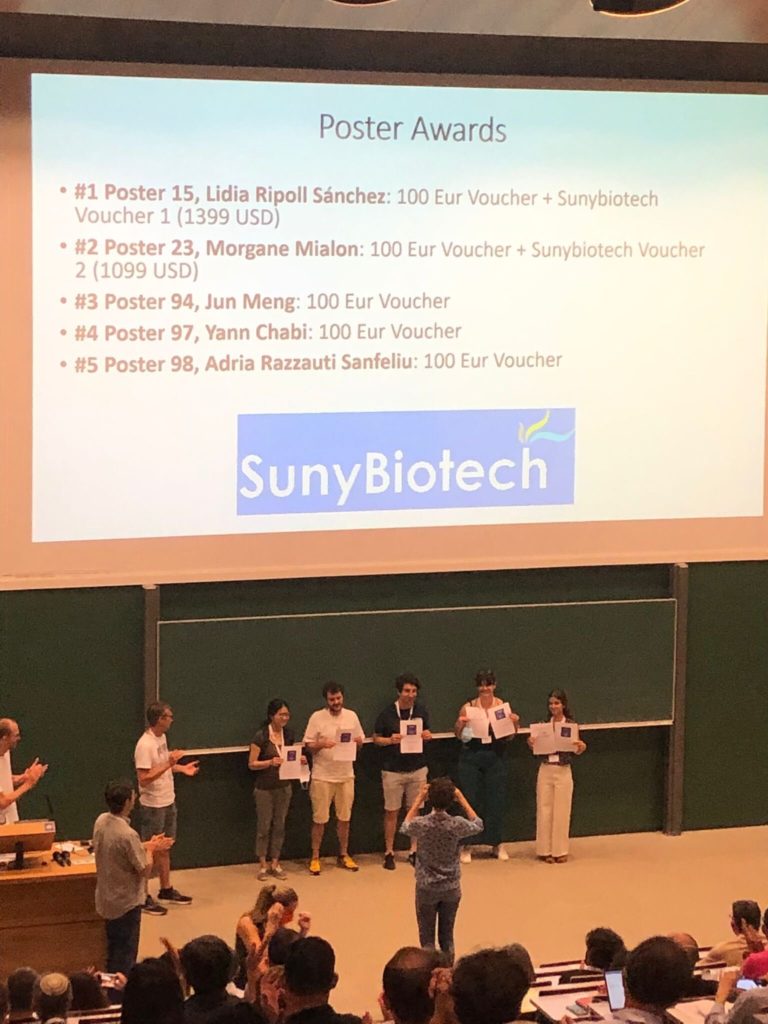
Congratulations to Jun Meng for coming in third place at CeNeuro 2022 for the Best Poster Award!
- An Artifact and Noise Correction Pipeline for Neuronal Calcium Imaging Data
Congratulations to Mohammad Haddadnia for featuring his poster, titled ‘An Artifact and Noise Correction Pipeline for Neuronal Calcium Imaging Data‘ at the Joint Biochemistry/Molecular Genetics Summer Student Program Poster Session!
- Julian Moran Completion Date
Congratulations to Julian Moran for the completion of his MSc study in Zhen Lab! You will be missed.
- Fields Undergraduate Summer Research Students 2022
Welcome to the Summer Research Students in the 2022 Fields Undergraduate Summer Research Program! We are excited to have Endri Mjeku, Maximilian Hofmann, and Szymon Sobczak join us in Project 8: Comparative Connectomics Using Random Graph Theory! They came from various countries around the world for a rich mathematical research experience in July and August.
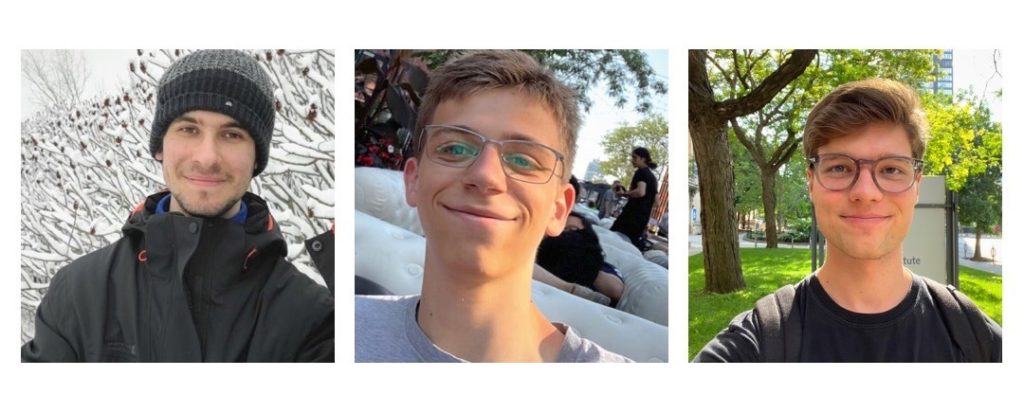
Endri Mjeku (l), Maximilian Hofmann (c), Szymon Sobczak (r) - Jayant Rai and NSERC
Congratulations to Jayant Rai for being awarded the NSERC Postgraduate Doctoral Scholarship, a federal award for Ph.D. students!
- Dylan Fong and NemaNode
Congratulations to Dylan Fong for his series of trips regarding NemaNode!
NemaNode is a set of tools that allow users to browse the C. elegans connectome data generated from Zhen Lab in a variety of visual formats (e.g. graphical network, 3D model visualization, etc.).
- OSOTF Award 2022-23
Congratulations to Alanna Love and Ze Nan (Tommy) Tang for receiving the Lunenfeld-Tanenbaum Research Institute Studentship, OSOTF award! We wish you both every success in your research career.
- Julian Moran
Congratulations to Julian Moran, for successfully defending his MSc thesis today!
- Mohammad and NSERC Summer Fellowship
Congratulations to Mohammad Haddadnia for being awarded the NSERC Summer Fellowship!
- Rory Gao
Congratulations to Rory Gao for being awarded a summer scholarship at the DSI institute (University of Toronto) and summer workshop in Biophysics at Princeton University!
- Ariana
Welcome to Ariana Krista San Diego – our new Administrative Assistant!
- Claire
Congratulations to Claire – promotion to a higher position! We will miss you but we are so proud of you too! Thank you so much for the hard work and care for everyone in the lab for the last two years.
- Leila
We are sorry to see Leila Lesanpezeshki go! Congratulations on landing your dream industry job in Toronto as a Data Scientist with INVIVO. We are proud of you, will will miss you… come back to visit!
- Ben et al post-embryonic
A new preprint at BioRxiv: Post-embryonic maturation of the C. elegans motor circuit. (PDF)
HIGHLIGHTS:
– Post-embryonic motor circuit maturation was reconstructed by synapse-resolution serial EM
– Motor patterns are maintained as the circuit matures from asymmetric to symmetric configuration
– Programmed rewiring gradually and sequentially transforms the circuit structure
– Preparatory and communicative wiring-rewiring allows maturation without functional disruption. - Welcome
We are excited to welcome Alanna Love and Ze Nan (Tommy) Tang, new MSc students, to the lab.
- (abstract) Natural sensory context drives diverse brain-wide activity during C. elegans mating
Now at Cell… Natural sensory context drives diverse brain-wide activity during C. elegans mating (PDF)
Natural goal-directed behaviors often involve complex sequences of many stimulus-triggered components. Understanding how brain circuits organize such behaviors requires mapping the interactions between an animal, its environment, and its nervous system. Here, we use brain-wide neuronal imaging to study the full performance of mating by the C. elegans male. We show that as mating unfolds in a sequence of component behaviors, the brain operates similarly between instances of each component but distinctly between different components. When the full sensory and behavioral context is taken into account, unique roles emerge for each neuron. Functional correlations between neurons are not fixed but change with behavioral dynamics. From individual neurons to circuits, our study shows how diverse brain-wide dynamics emerge from the integration of sensory perception and motor actions in their natural context.
- Structural Analysis … Ion Beam-Scanning Electron Microscopy
Now published Structural Analysis of the Caenorhabditis elegans Dauer Larval Anterior Sensilla by Focused Ion Beam-Scanning Electron Microscopy at Frontiers in Neuroanatomy! (PDF)
At the end of the first larval stage, the nematode Caenorhabditis elegans developing in harsh environmental conditions is able to choose an alternative developmental path called the dauer diapause. Dauer larvae exhibit different physiology and behaviors from non-dauer larvae. Using focused ion beam-scanning electron microscopy (FIB-SEM), we volumetrically reconstructed the anterior sensory apparatus of C. elegans dauer larvae with unprecedented precision. We provide a detailed description of some neurons, focusing on structural details that were unknown or unresolved by previously published studies. They include the following: (1) dauer-specific branches of the IL2 sensory neurons project into the periphery of anterior sensilla and motor or putative sensory neurons at the sub-lateral cords; (2) ciliated endings of URX sensory neurons are supported by both ILso and AMso socket cells near the amphid openings; (3) variability in amphid sensory dendrites among dauers; and (4) somatic RIP interneurons maintain their projection into the pharyngeal nervous system. Our results support the notion that dauer larvae structurally expand their sensory system to facilitate searching for more favorable environments. - New 3D models
We’ve been happy to receive so many requests for high resolution 3D renderings of C. elegans neurons (nerve ring) as described in our developmental connectome paper (Witvliet et al. 2021). To help distribute them, we’ve uploaded the 3D models and a blender file containing all the data. Feel free to share this link. Enjoy and have fun playing with them.

- Congratulations, Jun!
Congratulations to Jun Meng, a PhD student in our lab, for her successful final oral exam today for Molecular, cellular and circuit mechanisms that underlie a two-pore potassium channel’s regulation of membrane potential, synaptic activity and locomotion! Jun has been very focused on her completion and we are thrilled with how she defended today.
- Extrasynaptic signaling
See the pre-print of our latest paper
Extrasynaptic signaling enables an asymmetric juvenile motor circuit to produce a symmetric gait
Bilaterians generate motor patterns with symmetries that correspond to their body plans. This is thought to arise from wiring symmetries in their motor circuits. We show that juvenile C. elegans larva has an asymmetrically wired motor circuit, but still generates a bending pattern with dorsal-ventral symmetry. In the juvenile circuit, wiring between excitatory and inhibitory motor neurons coordinates contraction of dorsal muscles with relaxation of ventral muscles, producing dorsal bends. Ventral bending is not driven by analogous wiring. Instead, ventral muscles are excited uniformly by premotor interneurons through extrasynaptic signaling. Ventral bends occur in entrainment to the activity of the same motor neurons that drive dorsal bends. During maturation, the juvenile motor circuit is replaced by two homologous motor circuits that separately drive dorsal and ventral bending. Modeling reveals that the juvenile’s immature motor circuit provides an adequate solution to generate an adult-like gait long before the animal matures (PDF) - New names
We are thrilled to be back to close to normal in the lab! This means saying hello to new people, including Yi (visiting scholar), Jason (volunteering with the lab), and rotation students (Hetty, Ze Nan, Xenia) from the Dept. of Molecular Genetics. Welcome, everyone!
- Now at Nature
With the Lichtman and Samuel labs, we are happy to announce the official publication of Connectomes across development reveal principles of brain maturation at Nature.
The first wiring map of C. elegans was generated by pioneer Dr. John White and his colleagues at MRC Cambridge more than 30 years ago. It was a composite of partial maps from several different worms due to technical limitations in sample fixation, serial sectioning, and image processing. Inspired by the rigor and vision of the legacy work, we used state-of-the-art electron microscopes to reconstruct the full brain of eight C. elegans individuals to learn how they change with age.
This is the first time that the entire structure of the brain is individually deduced and compared across developmental stages from birth to adulthood. These findings have powerful implications for understanding the fundamental rules that allow the brain’s developmental maturation to take place.
By examining every connection for every neuron, muscle, and glia, we found that the overall geometry, neurite structures, and neurite appositions barely change after birth, but new connections are selectively added as animals grow older. Over the course of development, these additions maintain the brain’s central decision-making circuitry, whereas sensory and motor pathways become substantially remodelled.
By examining the relationship between the structural properties in the newborn’s brain and the adult wiring patterns, we found a few properties and a few “rules” for selective synapse addition, allowing us to correctly predict the wiring patterns of the mature brain.
By analyzing these connections that are like wires in a computational network, we discovered that the new additions follow patterns and their collective changes serve one purpose — enabling effective information processing. Through identifying some key patterns of the brain’s development, we found that substantial connectivity differences make each brain unique.
We are both humbled and honored by this opportunity to continue the C. elegans connectomics work. We thank Dr. Daniel Witvliet, a former PhD student at our lab, for his rigor, talent, generosity, and extraordinary leadership. We thank all the authors, contributors, and collaborators who have made this work wonderful and this experience beautiful. Last and not least, we thank Dr. John White for his warmth, support, encouragement, and vigorous review of our work.
Funding: Canadian Institutes of Health Research (CIHR), the National Institutes of Health (NIH), and Human Frontier, along with support from Sinai Health Foundation and the Radcliffe Institute for Advanced Study at Harvard University.
Dr. Ben Mulcahy (l), Dr. Daniel Witvliet (c), Dr Mei Zhen (r)
Drs. Witvliet and Mulcahy led the study alongside scientists from Harvard’s Brain Institute, including Drs. Aravi Samuel and Jeff Lichtman. - Christine’s completion
Congratulations to Christine Rehaluk on her recent successful defense of her Masters thesis in physiology!
“Electron Microscopy Analysis of the Gap Junctions of the Adult Caenorhabditis elegans“
Christine studied the bi-directional flow of charged ions and small metabolites through the gap junction pores. From two wildtype adult samples prepared using a Zhen lab protocol (a modified fixation protocol that allows better appearance of gap junctions in the C. elegans brain), Christine completed gap junction annotation, assessing the gap junctions where three innexin proteins that form gap junctions have been removed. Her results show that many gap junctions that reside in the wildtype brains are absent from the triple innexin mutant, validating that the fixation protocol has sufficient specificity for structural mapping of the gap junction connectome. Her comparison between two wildtype gap junction connectomes, as well as with that of the legacy wildtype connectomes, showed that at least some gap junctions are different between four wildtype individuals. The results are consistent with potential wiring differences among an isogenic population, a notion that has been recently validated for the chemical synapse connections. - Science Robotics Jul 2
We are pleased to announce the publishing of Towards a live soft microrobot: optogenetic locomotion control of Caenorhabditis elegans in Science Robotics (PDF)
- Preprint Britz et al
- Susoy
Congratulations to Susoy et al. for the recent acceptance at Cell of Natural sensory context drives divers brain-wide activity during C. elegans mating (Preprint)
- Witvliet in Nature
Coming soon in Nature: Connectomes across development reveal principles of brain maturation in C. elegans. Congratulations to the authors! (Preprint)
- Science Robotics Jul2021
Coming soon (July 2021) in Science Robotics: Towards a live soft microrobot: optogenetic locomotion control of Caenorhabditis elegans
- Rory Gao
Welcome to Rory Gao, an Engineering Science student at the University of Toronto who is joining us for a summer student!
- Ni Ji – elife
Congratulations to Ni Ji et al. Corollary neuron underlies motor feedback to sustain forward motor state now at eLife (PDF)
- Witvliet in nature
Witvliet et al. Connectomes across development reveal principles of brain maturation in C. elegans was recently accepted in Nature (preprint). Congratulations!
- Real-time volumetric in Nature Methods
Now available in Nature Methods Wang et al. Real-time volumetric reconstruction of biological dynamics with light-field microscopy and deep learning (PDF)
- Welcome Leila Lesanpezeshki
Welcome to Leila Lesanpezeshki – a new postdoctoral fellow who joins us from Texas Tech.
Leila’s PhD focused on developing phenotypic assays to study the neuromuscular function of C. elegans. She developed a 3D burrowing assay using a hydrogel to rapidly assess neuromuscular health in C. elegans disease models. In a NASA funded project, she collaborated on sending worms to space to understand the effect of microgravity on muscle strength during spaceflight using a microfluidic technology developed in her PhD lab. As an engineer at Zhen Lab, she will be leveraging her microfluidic knowledge to develop new assays to understand how neural connectivity affects the behavior and neuromuscular function. - We are pleased to welcome Jiacheng (Jackie) Chen!
We are pleased to welcome Jiacheng (Jackie) Chen, a new PhD student, to the lab.
- 2020 publications round up
A round-up of publications for 2020, great output with our colleagues:
– Overexpression of an ALS-associated FUS mutation in C. elegans disrupts NMJ morphology and leads to defective neuromuscular transmission. Markert et al. Biology Open (PDF)
– Open syntaxin overcomes synaptic transmission defects in diverse C. elegans exocytosis mutants. Tien et al. Nature Communications (PDF)
– Flexible motor sequence generation during stereotyped escape responses. Yuan et al. eLife (PDF)
– Efficient and cost‐effective 3D cellular imaging by sub‐voxel‐resolving light‐sheet add‐on microscopy. Zhao et al. J. Biophotonics (PDF)
– Optogenetic manipulation of postsynaptic cAMP using a novel transgenic mouse line enables synaptic plasticity and enhanced depolarization in the hippocampal dentate gyrus. Luyben et al. Frontiers in Neural Circuits (PDF) - Capturing the Continuous Complexity of Behavior in C. elegans
Capturing the Continuous Complexity of Behavior in C. elegans. Congratulations to Tosif Ahamed and Greg J. Stephens on this outstanding work published in Nature Physics! (PDF)
- Welcome to our four Fall20/Winter21 undergrads!
Welcome to our four Fall20/Winter21 undergrads – Samuel Wu, Alice Xu, Mohammad Haddadnia, and Randa Higazy is a 4th year thesis student!
- Welcoming Neeaja Ramakrishnan!
Welcoming Neeaja Ramakrishnan to the PhD program in physiology after her recent reclassification exam. Congratulations!
- Good-bye to Maggie Chang
Good-bye to Maggie Chang, who was with the lab from 2016-2020. We wish her well as she commences a PhD program in biology at McGill.
- Congratulations to Daniel Witvliet!
Congratulations to Daniel Witvliet for his second place win for “Reconstructing the Minds of a Worm” in the 2020 Show Us Your Brain Contest. See the video at the NIH BRAIN Initiative website.
For all the winners, click here - Many congratulations to Daniel Witvliet!
Many congratulations! Daniel Witvliet successfully defended his PhD in June. He’s now a PDF at Harvard.
- Well done on the hard work to Mona Wong!
Well done on the hard work to Mona Wong! She has transferred from the MSc program to a PhD.
- Congratulations to Yangning Lu!
Congratulations are in order! Yangning Lu successfully defended his PhD in February and has moved on to a postdoctoral fellowship at MIT.
- 2019 publications round up
A round-up of publications for 2019, great output with our colleagues:
– C. elegans neurons have functional dendritic spines. Cuentas-Condori et al. eLife (PDF)
– A 3D Model of Human Skeletal Muscle Innervated with Stem Cell-derived Motor Neurons Enables Epsilon-subunit Targeted Myasthenic Syndrome Studies. Bakooshli et al. eLife (PDF)
– An Upconversion Nanoparticle Enables Near Infrared-Optogenetic Manipulation of the C. elegans Motor Circuit. Ao et al. ACS Nano (PDF)
– Gain-of-function mutations in the UNC-2/CaV2α channel lead to excitation-dominant synaptic transmission in Caenorhabditis elegans. Huang et al. (PDF) - Welcome to Hongruo Zhang, William Li, and Julian Moran!
We are excited to welcome three new graduate students: Hongruo Zhang, William Li, and Julian Moran.
- Welcome to Tosif!
Welcome to Tosif Ahamed, our new Postdoctoral Fellow, from Okinawa! He is handling the cold shock alright.
- Congratulations to Daniel and Lisa on becoming parents!
Congratulations to Daniel and Lisa on becoming parents! Welcome, baby Andrew Zhao Witvliet!
- An upconversion nanoparticle enables near infrared-optogenetic stimulation
With Shangbang Gao: An upconversion nanoparticle enables near infrared-optogenetic stimulation, ACS Nano (PDF)
- Welcome to our new graduate student, Mona Wong!
Welcome to our new graduate student, Mona Wong!
- Congratulations to Min for completing his MSc study
Congratulations to Min Wu for completing his MSc study!
- An automated vesicle clustering algorithm
With Christian Stigloher and Philip Kollmannsberger: An automated vesicle clustering algorithm, PLoS One (PDF)
- Congratulations! Ben, Daniel, and our collaborators
Congratulations! Ben, Daniel, and our collaborators. Our EM method paper on the C. elegans connectomics is online. The first paper from this long and hard journey is finally out (PDF)
- A review on the C. elegans motor circuit
With Quan Wen and Shangbang Gao: A review on the C. elegans motor circuit, now published in Royal Philosophical Transactions B. (PDF)
- Congratulations to our collaborator, the Wen lab
Congratulations to our collaborator, the Wen lab. Their study of the forward motor circuit oscillator is accepted for publication by the PNAS. Glad to be part of this nice work
- A rare genetic disorder JBS is likely a glutamate homeostasis metabolic disorder
Congratulations to Jyothsna, Ria, Wesley, Renee, and our collaborators the Calarco and Dennis labs. Our finding that a rare genetic disorder JBS is likely a glutamate homeostasis metabolic disorder, via worm behaviors is accepted for publication at the PLoS Genetics
- Excitatory motor neurons are the C. elegans oscillators
Congratulations to Shangbang, Asuka, Jun, and our collaborators – the Jin, Alkema and Fang-Yen labs – for decoding oscillators of the C. elegans motor circuit
- Welcome, Katarina
Katarina Pankova completed her PhD at the Ludwig Maximilian University of Munich. She will be joining our lab as a postdoctoral fellow
- Welcome, Charline
Charline Roy, a visiting PhD student from the Bessereau Lab joined us this fall. Welcome to Canada!
- ZM10,000!
As of today, the Zhen lab generated 10,000 worm strains! Congratulations to Wesley Hung, who made the ZM10,000
- Funded by CIHR
Our mission, studying the basic biology of the C. elegans neural circuit development and function, has been awarded a CIHR Foundation Grant in the 2016-2017 competition. We are grateful for this opportunity
